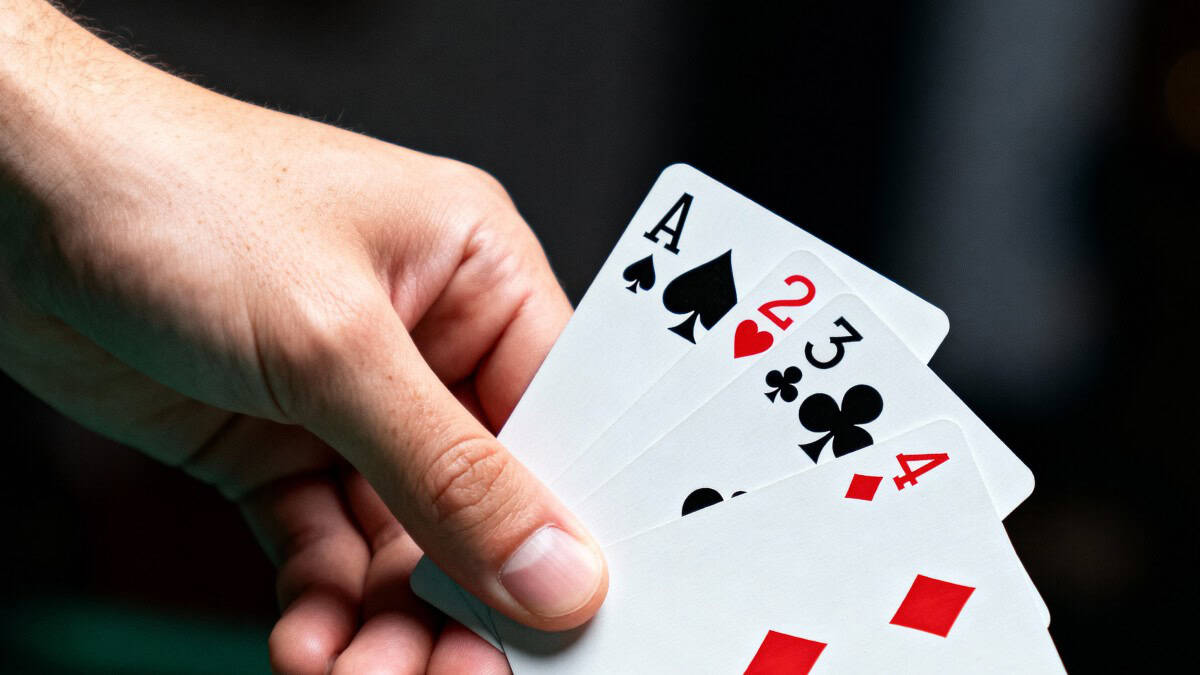
How to Play Badugi
In poker there are three main game variations;
- Flop games (i.e. Texas hold’em and Omaha)
- Stud games (i.e. Seven-card stud, Razz)
- Draw games (i.e. Five card draw, 2-to-7 Triple Draw)
Badugi is a draw game similar to triple draw. The hand values are similar to lowball poker, whereby players strive to obtain the lowest ranking hand. However, Badugi is a unique game. Players receive four cards and the objective is to create a hand of four distinct ranks and suits.
Badugi Hand Rankings
Unlike traditional poker variants, Badugi hand rankings follow a unique system. In Badugi, each player is dealt four cards, and the goal is to form a hand with all different ranks and suits. Any duplicate suit or rank is disregarded, reducing the strength of the hand. As a result, there are four distinct Badugi hand types, ranked from strongest to weakest as follows:
Badugi

A badugi hand is four cards that are all different suits and different ranks. Aces are low cards in Badugi and the objective is to create a low hand. Therefore our example is the best possible Badugi.
Here are more examples (ranked from best to worst):
Each of these hands contain four cards of different suits and ranks. When two or more players have a badugi, the best hand is determined by the highest card in each hand. If there is a tie for the highest card, the second highest card is compared, and so on. Suits are of equal value in Badugi, so if players share the same Badugi hand then the pot will be split.
Three Card Hand

When a hand contains identical ranks or suits, they are not counted. In our example you can see there are two 3’s, so one of these is discounted, leaving only three unique cards of a different rank and suit. Our example is a 3-2-A hand, the lowest possible three card Badugi hand.
Here are more examples (ranked from best to worst):



 (4-2-A)
(4-2-A)


 (9-8-6)
(9-8-6)


 (J-8-4)
(J-8-4)
Two Card Hand

This is a two card hand because there are only two cards that are unique in suit and rank. Of the three diamonds in this hand, the ![]() and
and ![]() would be discounted, meaning the hand is
would be discounted, meaning the hand is ![]()
![]() – which is the lowest possible two card hand.
– which is the lowest possible two card hand.
Here are more examples (ranked from best to worst):



 (3-2)
(3-2)


 (8-4)
(8-4)


 (K-T)
(K-T)
One Card Hand
Lastly, there are the one card hands.

In this hand only one card counts. Four Kings is the worst possible hand in Badugi, because a King is the highest ranked individual card (remember, Aces are low). This would be a great hand in Texas Hold’em, not so good in Omaha, but truly terrible in Badugi.
Here are more examples (ranked from best to worst):



 (2)
(2)


 (3)
(3)


 (7)
(7)
In each case, the hand features four cards sharing a suit or rank, leaving only the lowest card eligible. If two players hold one-card hands, the winner is determined by the lowest-ranked card. As the hierarchy goes, a Badugi outranks a three-card hand, a three-card hand beats a two-card hand, and so on.
The ranking structure is simple, and these illustrated examples make the rules easy to understand.
Badugi Hand Ranking Quiz
Which of the following hands is the best?

Hand A is a three card hand (5-4-3) because the King and three are both diamonds. Hand B is a badugi hand (King-high) because all four cards are of a different suit and rank. This means hand B is our winner.
Badugi Rules
Badugi is played as follows:
- A full Badugi table seats a maximum of 6 players
- Badugi is played using a fixed-limit betting structure
- Blinds are used like in Texas hold’em and Omaha
- Each player receives four face down cards to begin
The game starts with a round of betting, after which the first draw takes place. The first active player to the left of the dealer button can choose to draw cards to improve their hand. The player can also choose to “stand pat” and keep the hand as it is. Each player is in turn afforded the same opportunity of drawing cards.
In total there are three drawing rounds and four betting rounds (one before the initial draw). Badugi is played as a fixed-limit game so the opening two betting rounds use small bets, and the betting doubles for the third and fourth betting round. If there are players remaining after the final betting round then it will go to a showdown, with the winner taking down the pot.
Badugi strategy shares many fundamentals with other draw poker games, allowing core concepts to carry over. Winning in Badugi relies on reading opponents, identifying which hands they play aggressively, monitoring their betting and drawing tendencies, and applying classic poker principles such as positional awareness. Developing these skills can significantly boost your results in this fast-paced and highly engaging game.